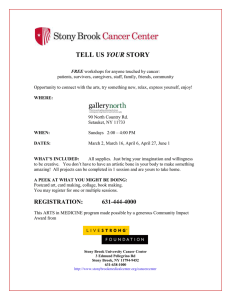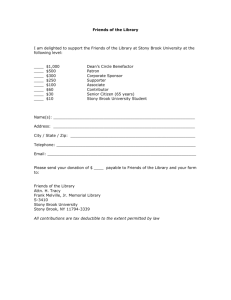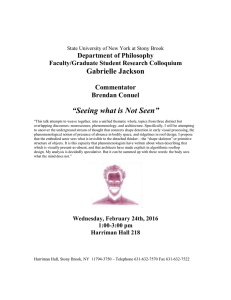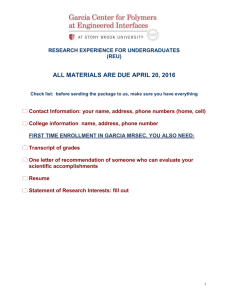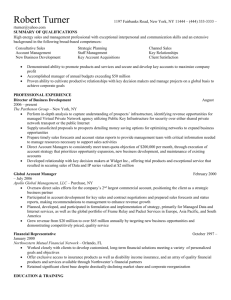A Talk on Lab History - Stony Brook University
advertisement
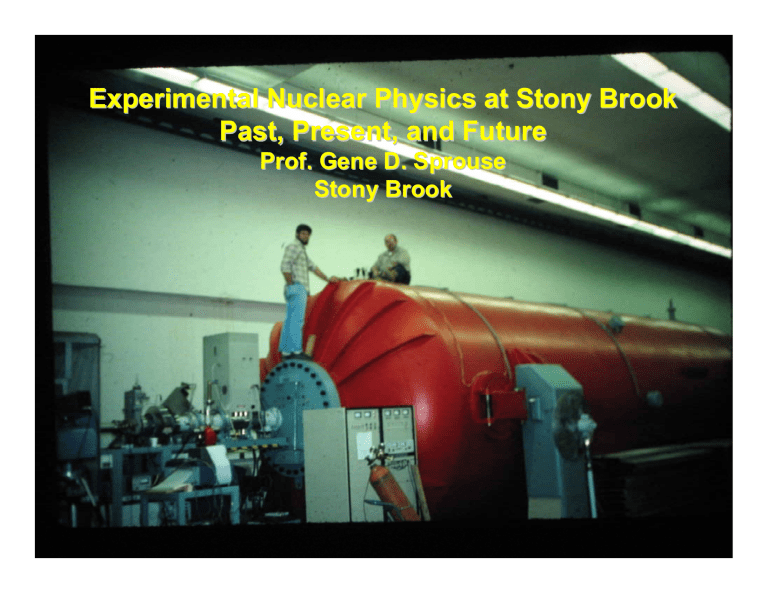
Experimental Nuclear Physics at Stony Brook Past, Present, and Future Prof. Gene D. Sprouse Stony Brook • Nov 24, 2006 4:00 pm Superconducting LINAC completed its last experiment at Stony Brook • This is an opportune time to review the history of the Van de Graaff and the LINAC and the people involved in their acquisition and operation, and to look into the future a little. Superconducting LINAC 1983 1975 Van de Graaff 1968 1966 Department of Physics 1964 Bob deZafra Cliff Swartz Juliet LeeFranzini Arnie Feingold Alec Pond Peter Kahn Proposal for EN tandem Van de Graaff to SUNY-Alec Pond Van de Graaff proposal s person Time Line for proposal • • 14 Dec 1962 24 Jan 1963 • 13 Feb 1963 Proposal prepared for EN (6MV) VdG. NSF issues positive report on Nuc. Physics, proposing to double funding and make money available to build facilities Provost Porter gets positive review Time Line for proposal • • 14 Dec 1962 24 Jan 1963 • • 13 Feb 1963 15 April 1964 Proposal prepared for EN (6MV) VdG. NSF issues positive report on Nuc. Physics, proposing to double funding and make money available to build facilities Provost Porter gets positive review State Legislature appropriates $1.35M for machine and ½ of the building, Time Line for proposal • • 14 Dec 1962 24 Jan 1963 • • 13 Feb 1963 15 April 1964 • 27 October 1964 Proposal prepared for EN (6MV) VdG. NSF issues positive report on Nuc. Physics, proposing to double funding and make money available to build facilities Provost Porter gets positive review State Legislature appropriates $1.35M for machine and ½ of the building, NSF grant for ½ of building ($291k) approved. Pond Proposes going for an FN(King) rather than an EN(Standard). This is known as “bait and switch” Time Line for proposal • 14 Dec 1962 Proposal prepared for EN (6MV) VdG. • 24 Jan 1963 NSF issues positive report on Nuc. Physics, proposing to double funding and make money available to build facilities • 13 Feb 1963 Provost Porter gets positive review • 15 April 1964 State Legislature appropriates $1.35M for machine and ½ of the building, other ½ ($291k) from NSF funding. • Jan 1 1965 First NSF research grant for $34,000 • Sept 1965 Lin Lee, Dave Fossan hired • Sept 1966 Peter Paul, Bob Weinberg hired • Oct 1966 Building started October-10-1966 (view from top of Harriman Hall toward Old Chemistry. Trees are site of Grad Chemistry building) November-10-1966 December-5-1966 February-1-1967 February-1-1967 Completed Van de Graaff building Trees at right rear of the building will become site of Grad Physics Building Delivery of the Van de Graaff tank We all live in a yellow submarine, Yellow submarine, yellow submarine, We all live in a yellow submarine, Yellow submarine, yellow submarine, Tank entering the building Current picture of the Van de Graaff Nuclear Experiment Facilities and Faculty 1965-2007 65 66 Van deGraaff FACULTY Robert Weinberg Linwood Lee David Fossan Peter Paul Robert McGrath Gene Sprouse resigned 67 68 69 70 71 72 73 74 75 Van de Graaff Physics Programs Gamma Ray Spectroscopy Dave Fossan Giant Dipole Resonance Peter Paul Charged Particle Reactions Bob McGrath Lin Lee Nuclear moments and applications to Solid State, Atomic Physics Gene Sprouse Two PDP-9 computers from DEC, each costing $100,000. The “big” machine had 16k 18 bit memory cells, and the “small” one 8k! The machine ran 24-7, and we hired people to operate the machine at night. Dr. Dan Dietrich, Livermore. (Metcalf student who did thesis with van de Graaff) Dr. Ron Chestnut, CPE at SLAC Dr. Phil Goldstone, Los Alamos The lab ski trip Igloo 101 Fred Raab, head of the LIGO Hanford Observatory (Metcalf student) Prof. Steve Rolston, Assoc. Chairman, Univ of Md. Prof. Partha Chowdhury, Univ of Mass. Lowell Ehud Dafni, VP Business Development, CMT Dr. John Noe, Laser Teaching Center Prof. Gunter Schatz, Univ. Konstanz • Friedlander Panel on Future of Nuclear Science NAS/NRC, 1975–77 recommends that two University Van de Graaffs should get “booster accelerators” • Peter Paul motivates the group to compete for one of these two. • Collaboration initiated with Cal Tech to build a superconducting LINAC at Stony Brook(We could not buy LINAC like vdG) • Paul and Sprouse stop physics research to devote full time to the project To expedite the transfer of the superconducting resonator technology to Stony Brook, Sprouse spends a semester at Cal Tech. Whose car is this?? Collaboration with Cal Tech to build superconducting resonators • There were competing development proposals to NSF from: – Stanford(Hanna, Glavish and Ben Zvi) – Stony Brook(Paul and Sprouse) • Stony Brook won! Testing the Prototype superconducting resonator with beam Ilan BenZvi, Director of the Accelerator Test Facility, BNL Next step: Test a prototype module containing 3 resonators What is the difference between these two proposals? The advanced computer control system of the accelerator was developed primarily by a PhD. Student Dr. Alfred Scholldorf, VP for development at Reuters Joseph M. Brennan, AGS Department, BNL Mike Brennan and Chen Chia-erh, work on the beam sweeper Chen later becomes President of Beijing University and President of the Chinese Physical Society Linac room before 400 W Helium Refrigerator Installation Professor Miriam Rafailovich, Director, Garcia Center, Materials Science Department, Stony Brook Helium gas storage tank delivery Installation of Bob McGrath’s scattering chamber “big mac” Linac room before Linac room after • SCIENCE Volume 291, Number 5506, 9 Feb 2001, p. 962. Copyright © 2001 by The American Association for the Advancement of Science. • NUCLEAR PHYSICS: Nuclei Crash Through The Looking-Glass David Voss Gloves do it. Toupees do it. Even twists of DNA do it. And now, for the first time, physicists have discovered that atomic nuclei come in right- and left-handed models, too. In the 5 February issue of Physical Review Letters (PRL), a team of researchers from the State University of New York (SUNY), Yale, the University of Tennessee, and Notre Dame reports observations of rapidly spinning nuclei morphing into mirror-image forms. In the process, the physicists also uncovered solid evidence that a long-disputed feature of nuclear anatomy really does exist. • • Starosta, Fossan, Koike, LaFosse, Beausang, and Vaman Nuclear Lifetimes of Fr Isotopes Made at Stony Brook Boulder 205 221 (work done with Luis Orozco, now at UMd.) 1.E+02 1.E+00 1.E-02 1.E-04 1.E-06 Isotope 229 225 217 213 209 1.E-08 201 Lifetime(seconds) 1.E+04 Francium Atomic Level Scheme (work done with Luis Orozco, now at UMd.) 9s 107.53±0.90 ns. 83.5±1.5 ns8p 3/2 8p1/2 149.3±3.5 ns 8s 67.7+-2.9 ns 7d5/2 7d3/2 73.60+-0.3 ns 53.48 +- 0.33 ns 6d5/2 6d3/2 7p3/2 21.02+-0.11 ns 7p1/2 29.45+-0.11 ns trapping transition 718 nm Found at Stony Brook Still unknown 7s Dave Fossan Bob McGrath Lin Lee Peter Paul Gene Sprouse Aniko Paul Dot Lee Ann Fossan Carolyn McGrath H’y Sprouse DAVID B. FOSSAN (1934-2003) 21 Ph.D. students, 17 postdoctorates, 260 refereed publications First recipient of “Chancellor’s Award for Excellence in Research and Creative Activity” • • • • • • • • • • • • 1. Neutron Total Cross Sections of Be, 10B, B, C and O, D.B. Fossan and R.L. Walter, W.E. Wilson and H.H. Barschall, Phys. Rev. 123, 209 (1961). 2. Differential Cross Sections for the T(p,n)3He Reaction, W.E. Wilson, R.L. Walter and D.B. Fossan, Nucl. Phys. 27, 421 (1961). 3. Rotational-State Lifetimes, D.B. Fossan and B. Herskind, Phys. Letters 2, 155 (1962). 4. Half-Lives of Two Excited States in 172Yb, B. Herskind and D.B. Fossan, Nucl. Phys. 40, 489 (1963). 5. Half-Lives of First Excited 2+ States (150<A<190), D.B. Fossan and B. Herskind, Nucl. Phys. 40, 24 (1963). 6. Protons from the 63Cu(p,p) Reaction, N. Cindro, D.B. Fossan and D. Zastavnikovic, Nucl. Phys. 50, 281 (1964). 7. Small-Angle Elastic Scattering of Neutrons and the Electric Polarizability of the Neutron, D.B. Fossan and M. Walt, Phys. Rev. Letters 12, 672 (1964). . . . 259. Signature inversion in doubly odd 124La H. J. Chantler, E. S. Paul, A. J. Boston, C. J. Chiara, P. T. W. Choy, A. Fletcher, D. B. Fossan, R. V.F. Janssens, N. S. Kelsall, T. Koike, D. R. LaFosse, P. J. Nolan, D. G. Sarantites, D. Seweryniak, J. F. Smith, K. Starosta, R. Wadsworth, and A. N. Wilson, Phys. Rev. C 66, 014311 (2002) 260. Observation of excited states in the near-drip-line nucleus 125Pr A.N.Wilson, D.R.LaFosse, J.F.Smith, C.J.Chiara, A.J.Boston, M.P.Carpenter, H.J.Chantler, R.Charity, P.T.W.Choy, M.Devlin, A.M.Fletcher, D.B.Fossan, R.V.F.Janssens, D.G.Jenkins, N.S.Kelsall, F.G.Kondev, T.Koike, E.S.Paul, D.G.Sarantites, D.Seweryniak, K.Starosta, and R.Wadsworth, Phys.Rev. C66 , 021305 (2002) Dave Fossan, one of the creators of “Gammasphere” NSF Funding of Nuclear Structure Laboratory $1,000,000 ∫ = $41.2Μ Year 2007 2004 2001 1998 1995 1992 1989 1986 1983 1980 1977 1974 1971 1968 $0 1965 Funding/year $2,000,000 Department Visiting Committee Comments on Nuclear Physics The Future: Linac: Beijing Atomic Energy Institute wishes to acquire the LINAC as a booster for their tandem. Van de Graaff: MARIACHI (Cosmic ray detectors for outreach to high schools) Tandem Teaching Lab (experiments for advanced laboratory, and C14 dating for outreach) Detector Research and Development A. Deshpande, A. Drees, T.K. Hemmick, B. Jacak, M. Marx Mariachi Workshops Accelerator Mass Spectrometry • AMS is well established for 14C, 10Be, 26Al, 36Cl, 41Ca, 129I. • 14C is the familiar “dating” isotope for biological samples. • Living materials contain 14C/12C~10-12 • After death, ratio decays t1/2=5730 yr • Accelerator used to strip ions to +3 charge state, eliminating molecules. • 12C via beam current, 14C via count rate Proposed Lab Layout: MARIACHI 14C Grad Lab Det R&D Winder Concluding remarks • Alec Pond’s vision has largely been realized: The purchase of the Van de Graaff was one of several statements that Stony Brook intended to be a major research university. • Peter Paul’s vision to go after the LINAC has paid off well. • Peter also played a pivotal role in securing RHIC for BNL. • The Van de Graaff will continue as a productive educational and outreach tool. Personal remarks • Came to Stony Brook, January 1970 • Will go on 5 year leave, starting January 2007 to become Editor in Chief of the American Physical Society. • I have worked hard for Stony Brook, and Stony Brook has been good to me. I’ve enjoyed my interactions with my colleagues and the outstanding SB students, especially the last 4 years teaching Honors Physics 141-2. • My new job is different, with new challenges, and I’m excited about taking them on. The The End End For material used in this presentation, many thanks to: Peter Kahn, Lin Lee, and John Noe
